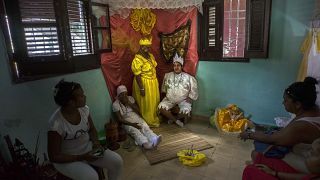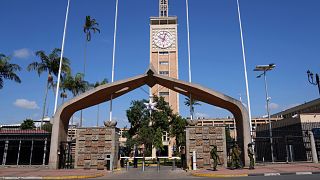Cuba
The 1959 Castro-led revolution installed an atheist, Communist government that sought to replace the Catholic Church as the guiding force in the lives of Cubans.
But 65 years later, religion seems to be everywhere in Cuba, in dazzling diversity.
The bells toll in Catholic churches and the call to prayer summons Muslims in downtown Havana. Buddhists chant mantras as they gather at the home of a jazz musician. Jews savor rice, beans and other Cuban staples for Sabbath dinner. Santeria devotees immerse the senses as they dance and slap drums in a museum filled with statues paying homage to their Afro-Cuban deities, and leave offerings to the goddess of the ocean.
It’s also visible in the growing ranks of evangelicals who worship across the island, in the faith of LGBTQ+ Christians who sing at an inclusive church in the seaport of Matanzas, or in the pilgrims who travel to the remote shrine of Cuba’s patron saint in the shadow of the Sierra Maestra mountains to ask for health and prosperity during a wrenching economic crisis.
Critics say Cuba is still falling short on religious tolerance. The U.S. State Department has designated Cuba a “Country of Particular Concern” for having engaged in or tolerated severe violations of religious freedom.
Cuba's constitution includes provisions for religious freedom and bans religious-based discrimination. But a recent State Department report says provisions in Cuba's penal and administrative codes "contravene these protections.” The report says the Cuban Communist Party requires religious groups to be officially registered, “and membership in or association with an unregistered group is a crime.”
The report says the Office of Religious Affairs and the Ministry of Justice continue to withhold registration to some groups, including the Jehovah’s Witnesses and The Church of Jesus Christ of Latter-day Saints.
Cuba’s government says the criticism is just another excuse for Washington to justify the decades-old economic embargo that dates back to the Cold War.
Some academics and religious leaders say more strides toward full religious freedom are needed, such as easing the process to build houses of worship, allowing access to state-owned media to spread their faith-based messages, and re-establishing private religious schools. But significant progress has been achieved; some call it a time of a Cuban religious revival.
More than 60% of Cuba’s 11 million people are baptized Catholic, according to the church. But experts estimate that as many, or more, also follow Afro-Cuban traditions such as Santeria that intermingle with Catholicism.
“Cubans are believers, but sometimes they believe in everything,” said Monsignor Ramon Suarez, chancellor of the archdiocese of Havana and author of “History of the Catholic Church in Cuba.”
Cuba’s religious landscape is so diverse that it would be wrong to simply say the island is Catholic or Afro-Cuban Santeria, said Maximiliano Trujillo, a philosophy professor at Havana University who has written about Cuban religion.
“There’s a very unique religiosity,” he said. “In Cuba, it’s not uncommon that someone goes to meet a babalao (Santeria high priest) in the morning and can visit a Pentecostal temple in the afternoon, and at night goes to Mass – and doesn’t see any type of conflict in its spirituality.”
Today, diverse beliefs can be found mixed together on altars in homes, with the Virgin Mary sharing space with a ceramic Buddha and a warrior spirit from the Afro-Cuban faith.
The Catholic Church — long associated with Cuba’s wealthier citizens — took an anti-communist stance shortly before Fidel Castro declared the country to be socialist in 1961.
The government later accused prominent Catholics of trying to topple Castro. Public religious events were banned after processions were transformed into political protests, sometimes turning violent.
Church-state relations began to warm three decades later when Castro met with dozens of evangelical leaders of different denominations and representatives from the local Hebrew Community. In 1992, the government dropped its constitutional references to atheism. The first papal visit to the island in 1998 marked a turning point that led to government acceptance of some outdoor religious events and the celebration of Christmas outside churches for the first time in more than three decades.
Arguably the most popular religion in Cuba is Santeria, which fuses Catholicism with Afro-Caribbean traditions.
Santería was born as a form of quiet resistance among Cuba’s Black communities. It dates back centuries to when Spanish colonists brought hundreds of thousands of enslaved Africans to Cuba, many from the Yoruba tribe of Nigeria.
The Spanish tried to force Catholicism on the enslaved, but the Africans who made that transatlantic voyage brought their own religions, camouflaging them by attaching symbols of their orishas – Yoruba deities – to Catholic saints.
Gloria Esperanza Reyes, a historian of the Yoruba Association, has for decades made a monthly offering of flowers and cane syrup to the goddess of the ocean after doctors told her that she wouldn’t live long because of a heart condition. She recently turned 82.
Santeria long remained on the political margins due to its scattered, non-hierarchical nature and centuries of taboo and racism. In recent years, it has grown in prominence.
These days, music from Santeria drum ceremonies echoes from inside the Yoruba Cultural Association of Cuba into the American Brotherhood Park, known for its large ceiba, a sacred tree in Afro-Cuban religions. On a recent day, young dancers synchronized their moves to the fast batá drumbeat at a rehearsal paying homage to their orishas.
“I have so much faith in my saint,” said dancer Susie Stuart Castellanos.
Nearby was a statue of Yemaya, the Yoruba goddess of the sea. She also is venerated in her sky-blue shawl as Our Lady of Regla, a Black Madonna at a Catholic church across the Bay of Havana.
At Cuba's largest synagogue, ancient Jewish traditions and Cuban culture often blend. At times, Sabbath dinners at Beth Shalom include Cuban black beans and rice — a popular dish known as Moros y Cristianos or Moors and Christians. During Rosh Hashana, Jews around the world traditionally dip apples in honey to wish each other a sweet new year. But Beth Shalom congregants say they have instead used easier to find tropical fruits like guavas and bananas.
Jews are believed to have arrived in Cuba with Christopher Columbus in 1492, but the Cuban community officially began in the early 20th century, said Hella Ezkenazi, vice president of Cuba's Hebrew Community and principal of the local Albert Einstein school. After WWII, more European Jews arrived.
The community grew to an estimated 15,000 at its peak in the 1950s, but most emigrated to the U.S. after the 1959 revolution when many of their businesses where confiscated and nationalized.
As the sun set on a recent Friday, about 100 members of Beth Shalom gathered for the Sabbath to pray. Several later joined hands in an Israeli dance infused with Cuban rhythms.
“We are Jews, that sense of belonging that is my identity in spite of living here (in Cuba) as I reflect myself in Israel,” said Betina Acosta, 24, who is part of the Israeli folk dance group and teaches the congregation's children at Sunday school.
The only mosque in Havana opened in 2015 and the Muslim community has grown to about 2,500 people nationwide, said Ahmed Aguero, one of the mosque’s leaders. He owns a nearby restaurant where community members often gather.
“We’re pioneers in spreading the religion (here),” he said. “People don't know about the religion, people are amazed. People have a bad impression of Muslims, (they fear) that we’re bad or even terrorists, until they meet us and they learn about the real practice of our religion."
Among the mosque’s worshippers is Ubakar Bari, who emigrated from the West African nation of Guinea-Bissau. He was grateful to find a welcoming Muslim community that offered him a meal and helped him rent a room.
“I never thought I’d find a community like this in Havana,” he said.
Twin brothers Yasnel and Yasmel Quintana were raised in an Afro-Cuban family that follows Santeria, but they never practiced that faith. Instead, they were exposed to a subculture of manga comics, animated movies and video games and began to learn Japanese — an example of how one of the world's least connected countries has adapted to global trends. Ten years ago, they joined the local branch of the Soka Gakkai, a global Japanese Buddhist organization.
On a recent Sunday, they went to the home of Cuban jazz musician Cesar Lopez and his wife, Japan-born Seiko Ishii, where group members often meet to meditate.
“(Buddhism) became our first and only religion, where we felt identified and decided to grow as a person and spiritually,” said Yasmel.
Soka Gakkai is present in more than 190 countries, according to the group.
In Cuba, it grew from a few people in 2015 to about 500 today.











Go to video
Robot waiter becomes a star attraction at Havana restaurant
01:25
Followers of Afro-Brazilian religions pay tribute to sea goddess for New Year
01:48
Cuba: Afro-descendant women and men showcase the beauty of their hair
01:12
European Supercup: Cuba's Mijaín López welcomed as a hero after winning his 5th Olympic gold medal
00:50
Cuba joins South Africa's legal action at the ICJ against Israel's actions in Gaza
02:20
Cuba's traditional 'guayabera' shirt on the way to global icon status